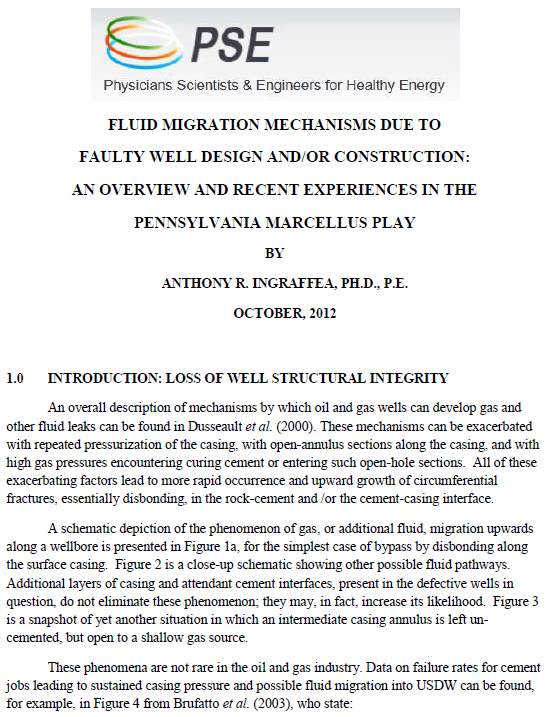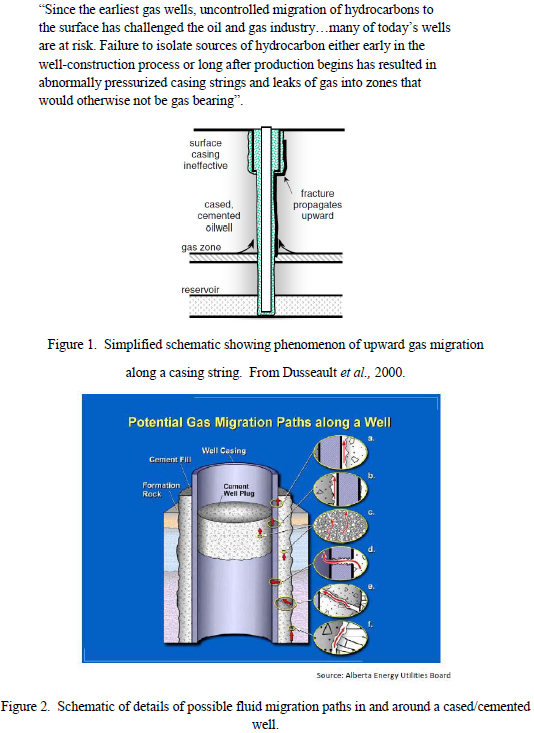Fluid Migration mechanisms due to faulty well design and / or construction: An overview and recent experiences in the Pennsylvania Marcellus Play by Anthony R. Ingraffea, Ph.D, P.E., October 2012, Physicians, Scientists and Engineers for Health Energy
The science on contamination of drinking water from shale gas drilling, fracing, and production, is recent, ongoing, and incomplete. A peer-reviewed, archival journal study from Duke University (Osborne, et al., 2011) found apparent migration of substantial amounts of methane from gas wells to private water wells as far out as 1000m in the Marcellus play in Pennsylvania. A more recent paper from the Duke University team (Warner et al., 2012) documented geochemical evidence for possible natural migration of Marcellus formation brine to shallow aquifers in Pennsylvania. Also, the U.S. Environmental Protection Agency (EPA, 2011) recently released a preliminary report from an on-going study in Pavilion, WY, that suggests that substances used in fracing might migrate into adjacent water-bearing strata. The study also found clear evidence that there had been migration of methane from gas wells to nearby drinking water wells – likely caused by deficient cement jobs. Inadequate well construction and, of course, spills have been implicated in many states in a large number of cases of migration of drilling related substances into nearby drinking water.
Along with these fairly direct evaluations of the migration of methane and other substances, industry sources have asserted that private water wells are often contaminated by “naturally occurring” methane. This is often presented in an apparently analytical but confusing way, suggesting that the appearance of methane in drinking water wells is sort of “common” and thus unlikely related to any gas well drilling. Such presentation fails nearly entirely to, first, distinguish between dangerous/hazardous levels of methane in water (7 mg/L or more in PA), and much lower levels that are not generally taken to be of concern. Second, it ignores the prevalence or likelihood of having a dangerous “natural” level of methane in drinking water. Third, it ignores any time line: has there been any significant change in the concentration of methane concurrent with the beginning of nearby gas field development?
The New York DEC’s data (NYS rdSGEIS, pg. 4-39) make crystal clear that for a 2010 sample of water wells (n=46) in the “Delaware, Genesee, and St. Lawrence River Basins,” presumably not near gas wells, just 2% of the wells had a dangerous level over 10 mg/L. One well had a level of 22 mg/L; the remaining wells then had an average level of 0.31 mg/L. This low percentage of “normal” risk has been confirmed repeatedly in studies in PA, Figure 6, in the Southern Tier of NY (1450 water wells, USGS, 2010), in Alberta, Canada (360,000 wells, Griffiths, 2007) and by both independent investigations and by testing by gas drillers (e.g., Boyer, et al., 2011). None of these findings suggest, in any way, that dangerous levels of methane are at all common in rural private water wells. Thus, a fairly strong implication is that, if and when methane does occur at high levels in water wells near gas drilling, it is likely due to some aspects of gas drilling, fracing and/or production operations themselves. This is consistent with both the Osborn, et al. (2011) study and the EPA Pavilion (2011) preliminary report. Exact migration mechanisms are not yet completely clear in each case, but the potential well failure mechanisms described in the previous section are often implicated. [Emphasis added]



